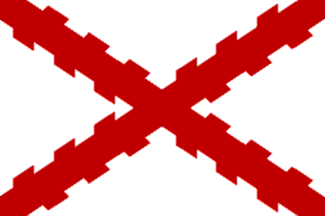
by Blas Delgado Ortiz, 4 March 2000

Last modified: 2001-11-03 by dov gutterman
Keywords: puerto rico | burgundy cross | cross (burgundy) |
Links: FOTW homepage |
search |
disclaimer and copyright |
write us |
mirrors

by Blas Delgado Ortiz, 4 March 2000
See also:
Some friends who were in Puerto Rico over Christmas described
a commonly seen flag (along with the Stars and Stripes and the
Puerto Rican flags): The flag is a St. Patrick's cross, red on
white, but the cross is made of 9 "bricks" on each
diagonal, instead of being a single straight-edged band. (This is
a crude gif.)
Rob Raeside, 20 January 1998
This is the "Cross of Burgundy," one of the
standards of Spain that was used by the Spanish Military in the
South East US.
Nathan Bliss, 20 January 1998
It's not the usual Cross of Burgundy. This is "argent,
gnarled cross gules", but the one that was flown in Puerto
Rico was definitely a cross made of horizontal
"bricks". It was flying at El Morro, an old fort in San
Juan -- it may be the flag of the city of San Juan?
Rob Raeside, 21 January 1998
The "Cross of Burgundy" flag is the Spanish military
flag. My understanding is that is was not used after the 1780's.
It is flown over San Cristobal fort, El Morro fort, and some
other buildings that were official buildings under Spain as an
historical thing. The cross does not reach the corners.
Anna Stone Jimanez, 31 October 1998
I saw your webpage on Puerto Rican flags and I would like to
clarify something about the "Cross of Burgundy" Flag.
This flag is not the "Cross of Burgundy" but "La
bandera de San Andres de la Infanteria." translated
"The flag of St. Andrew of the Infantry." St. Andrew is
the patron saint of the Spanish Armed Forces (Even to this day.)
The White and Red flaming cross represents the colors of "El
Tercio de Nueva Espaņa". This regiment became the 29th
local infantry regiment that saw action in the British invasion
of Puerto Rico in 1798, The Spanish-French war of 1809, The war
of 1812 in Louisiana under the command of Bernardo de Galves and
the Spanish-American War of 1898, where the regiment was
disbanded after the conflict ended in favor of the U.S. The Flag
is still flown at San Felipe del Morro Castle in San Juan as a
tribute to this regiment.
Marcos Rodri'guez , 1 October 1999
The basic pattern of a "saltire raguly couped Gules", or plainly speaking a red saltire resembling two crossed, roughly-pruned branches, on a usually white field (but also blue, purpure etc.), was the Spanish military flag from the 15th century up to 1843, when the red-2 yellow-red ensign was adopted for use on land too. The saltire was originally a Burgundian emblem, first introduced in Spain as the personal badge of Phillip the Handsome, Duke of Burgundy and King Consort of Castile and Aragon, married to Joan of Castile and Aragon (daughter of the Catholic Kings Ferdinand and Elizabeth), the parents of Charles I (Charles V as German Emperor). As such, the emblem has been called in Spain "cross [or, more properly, saltire] of Burgundy", even if the term &quo